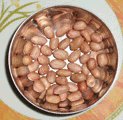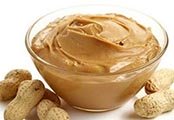Selection and storage

|
 |
| Peanut kernels in a bowl. | Peanut butter. |
Peanuts are typically available year-round in markets. Various types, including shelled, unshelled, salted, and sweetened, are commonly found in stores for purchase. Opt for unshelled nuts (with intact outer shells) instead of processed ones, typically sold in airtight packs or bulk bins. Look for pods with compact, off-white, healthy-looking shells that are uniform in size and feel heavy in hand. Ensure they are free from cracks, mold, spots, and any rancid smell.
Unshelled groundnuts can be stored in a cool, dry place for several months, while shelled nuts should be kept in an airtight container in the refrigerator to prevent them from becoming rancid.
Preparation and Serving Methods
-
Peanut kernels can be enjoyed as-is, either by cracking them with firm pressure between fingers or using clippers or a nutcracker machine. Alternatively, they can also be consumed roasted, boiled, salted, or sweetened.
-
They possess a nutty yet pleasantly sweet taste. Roasting enhances their flavor, increases antioxidant levels such as p-coumaric acid, and helps eliminate toxic aflatoxin.
-
Roasted and crushed kernels are often sprinkled over salads and desserts, particularly sundaes and other dairy-based preparations.
-
Boiled peanuts offer a unique flavor and taste. Boiling enriches their nutritional and antioxidant profile.
-
Bumbu kacang (peanut sauce) is a well-known preparation that incorporates fried peanuts, palm sugar, shallots, galangal, garlic, tamarind, lemon juice, lemongrass, salt, chili, pepper, and sweet soy sauce, ground together and mixed with water to achieve a semi-solid texture.
-
Peanut butter is a food paste made from roasted nuts, with or without the addition of oil. It is popular as a dip or spread. Peanut milk is also a favored lactose-free healthy drink.
-
Peanut “chutney” or paste, made from these nuts, chili peppers, salt, coriander leaves, garlic, and mustard seeds, is a popular dip in South Indian and Sri Lankan regions.
-
Peanut oil is another healthy source of edible cooking oil, akin to soy or olive oils. Widely used in cooking for its aromatic flavor, it is especially popular in South Indian States and Sri Lanka.
Safety Profile
Peanut allergy is a form of hypersensitivity response exhibited by certain individuals to food substances containing these nuts. This heightened immune reaction can lead to severe physical symptoms such as vomiting, stomach pain, and swelling of the lips and throat, potentially resulting in breathing difficulties, chest congestion, and, in extreme cases, death. Consequently, it is strongly advised for these individuals to avoid any food preparations containing peanut products.
Peanuts are particularly prone to fungal (mold) infections, notably by Aspergillus flavus, which produces aflatoxin. Aflatoxin is a potent and hazardous carcinogen capable of causing liver cirrhosis and cancer. Roasting can help diminish toxin levels in peanuts, providing some measure of protection against aflatoxin. (Medical disclaimer)
Also read ≻≻-
≻≻-Hazelnuts Nutrition facts and health benefits.
≻≻-Peanut Oil-Nutrition facts and health benefits.
≻≻-Back to Nuts and seeds from Peanuts. Visit here for an impressive list of nuts and seeds with complete illustrations of their nutrition facts and health benefits.
≻≻-Back to Home page.
Further Reading:
-
Refer Stanford Medicine cancer center information page-Nutrition to reduce cancer risk.

